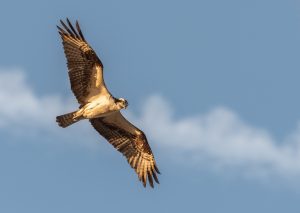- Introduction
- Predators
- Loss of Habitat
- Contaminants
- Change in Migration Routes
- Climate Change
- Plans for the Future
The presence of top predators can affect prey behavior, morphology and life history, and thereby can produce indirect population consequences greater and further reaching than direct depredation would have alone.
The pesticide DDT (dichlorodiphenyltrichloroethane) was banned in the United States in 1973 and conservation measures were implemented. The breakdown products of this chemical, DDE, affected the formation of egg shells in birds. Top predators such as hawks and falcons were affected the most, because these toxic chemicals bio-accumulated in their bodies. That is, the higher up the food chain a bird was, the more of this chemical was incorporated into their bodies from the prey that they ate. Eggshells thinned and eggs broke while in the nest, thus killing the chick inside. Predators’ populations plummeted. However, once DDT was banned, their populations slowly began to grow, and today, predators such as the peregrine falcon, are experiencing healthy population growth. This has been likened to a hemisphere-wide predator-reintroduction experiment. The recovery of peregrines began in the 1980s, and they were removed from the endangered species list in the United States in 1999.This reintroduction of raptors by eliminating DDT is hypothesized to have had profound effects on populations of their prey, mainly shorebirds. They are now major threats.

Many falcons and hawks have a seasonal migration, as do shorebirds along the same route. Thus, shorebirds are vulnerable to predators at their stopover sites where they stop to refuel.
Smaller sites that are near raptor cover have had large decreases in populations. The reason for this is that the wetlands are sheltered by trees and give cover to falcons, which can attack stealthily and with enough speed that sandpipers cannot escape. Data from the Canadian Wildlife Service show decreased population trends on the northward migration, where numbers have slowly been decreasing since the 1980’s (83% since 1992). Length of stay and body mass of western sandpipers have also been decreasing at these small sites.
Large sites, on the other hand, are usually vast mudflats where approaching avian predators are easily seen and thus the shorebirds can escape. These are the sites where numbers have not decreased radically at large sites. However, it is not known yet whether or not birds from small sites have assimilated into populations at the larger sites.
Such behavioral changes in times at refueling stations are probably general among migratory shorebird species, and may be contributing to the reported widespread census declines reported in North America.
